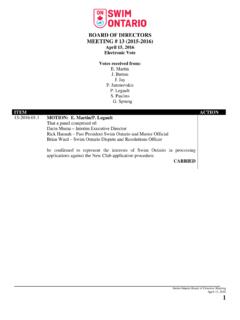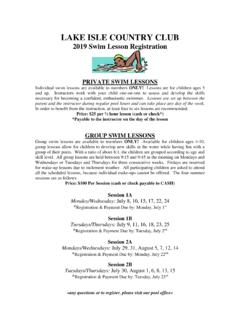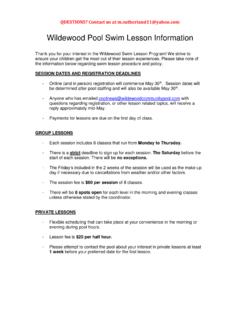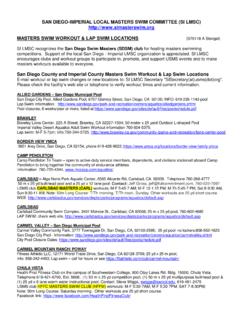Transcription of Swimming Jargon - Off The Blocks
1 Swimming JargonA (A Cut)Is a time classification for a swimmer or a swim . Known as the National Age Group Time Standard A. A times are faster than the BB time standards and slower than the AA time standards. AA (AA Cut)Is a time classification for a swimmer or a swim . AA is faster than A time (AAA Cut)Is a time classification for a swimmer or a swim sometimes called a Zone cut. AAA is faster than the AA time standard. AAAA (AAAA Cut)Is a time classification for a swimmer or a swim . It is faster than the AAA time standard and is the fastest typically listed in times swim meet that requires swimmers to have previously swam an A time standard in events they wish to MeetSwim meet that offers separate competition for both A swimmers and B swimmers. Swimmers compete in separate brackets against other swimmers of similar meet similar to an A-B meet except that there are 3 divisions.
2 Swimmers compete in separate brackets against other swimmers of similar Up Aggregate TimeFor a relay, the times achieved by 4 swimmers in individual events are added together to arrive at an entry GroupThe National Age Group divisions are: 10-under, 11-12, 13-14, 15-16, and 17-18. Occasionally, a meet will use non-standard divisions such as: 8-under, 13-Over, and 15-Over. Age grouping is used so that swimmers compete against others of similar size and some meets, swimmers participate in prelims round and the fastest quality to swim in finals. These meets are called Prelims/Finals meets. After the finalists are determined, the next two fastest swimmers are called the alternates. If a finalist cannot participate, the alternates are called to take their last swimmer in a MeetSwimmers may use times achieved at an approved or sanctioned meet to qualify for zones, nationals and other meets that require time standards.
3 If a meet is not approved, the times cannot be used for (B Cut)Is a classification for a swimmer or a swim . National Age Group Time Standard B time is faster than the C time standard and slower than the BB time (B Cut)Is a classification for a swimmer or a swim . National Age Group Time Standard BB time is faster than the B time standard and slower than the A time swim meet that requires swimmers to have previously swam an A time standard in events they wish to MeetSwim meet that offers separate competition for both B swimmers and C swimmers. BackstrokeOne of the 4 competitive racing strokes. The start is unique, typically from in the water rather than off the Blocks . It is the first stroke in the Medley starting platforms for each lane. Bonus HeatIn a Prelims/Finals meet, there may be either 2 or 3 finals heats. If there are three heats, the first or slowest, is called the bonus of the 4 competitive racing strokes.
4 It is the second stroke in the Medley Relay and the third stroke in the It has a unique frog style of the 4 competitive racing strokes. The butterfly, also called the fly, is swam as the third stroke in the Medley Relay and first stroke in the It has a unique dophin style several purposes including protecting hair from pool chemicals and can improve hydrodynamics. They are made from several different materials. Logo's, flags, and other decorations can adorn them, although some organizations limit the size of these some swim meets, cards are used to help keep the meet organized. Each card lists the swimmer s name along with event, heat, and lane assignment. It will sometimes include the swimmer s USA number, seed time, or other info. After races, times are written on these cards by lane timers. Cards are collected and used to determine the order of finishes, times, MeetA meet held at the end of a season.
5 Qualification times are nearly always necessary to enter a championship FinalsThe fastest qualifying swimmers in a Prelims/Finals meet. The number of qualifiers depends on the pool and meet the beginning of some swim meets, swimmers must check off or circle their name to signify that they have made it to the meet. ChlorineThe chemical used by most pools to keep it clear and safe to swim SeedingA method of determining who swims in which lanes. The fastest 18 to 24 swimmers (depends on pool) are seeded in the last three heats of an event. The fastest swimmer is in lane 4 of the last heat, the next fastest is in lane 4 of next to last heat, and so on until all lanes are registered swim team that pays dues to USA set of rules, ethics, and conduct that both swimmers and coaches are required to sign at certain USA/LSC sponsored events.
6 The Code is not strict and involves common sense and proper FinalsIn a Prelims/Finals meet, the next to fastest heat in finals is referred to as the consolation finals. Regardless of how fast a swimmer is in the consolation finals, their rank finish in the event cannot move up past those in the fastest finals heat. Course The length of the pool. Long Course = 50 meters / Short Course = 25 yards or 25 date meet entries must be postmarked to be accepted by the meet area around the Swimming pool. At USA swim meets, only authorized USA members, swimmers, and coaches may be on the deck during a swim competition. Deck EntriesMost of the time, swim meet entries are made will ahead of a swim meet. But some swim meets allow swimmers to enter an event during a meet. DevelopmentalA kind of meet or competition held for the purpose of allowing all levels of swimmers to compete in a low pressure swimmer s performance is not counted because at least one rule concerning performance was broken.
7 A disqualification is signaled by an official typically by raising one arm with open TimeWhen a swimmer goes faster than the previous best performance they have dropped their exercises and various strength programs swimmers do out of the Individual, Relay team, or Club roster's list indicating who will swim what events in a swim FeesThe amount per event a swimmer or relay pays to participate. Electronic TimingThe timing system usually has touchpads in the water, buttons humans press for backup timing, and a computer type console that prints out the results of each race. Some systems are hooked up to a scoreboard that displays swimmer s race or stroke over a given distance. Events have one or more heats depending on the number of swimmers entered in the event. False StartWhen a swimmer leaves the starting block too early or moves while they are supposed to remain still.
8 A false start will disqualify a swimmer or a relay to SlowestA seeding method used on many longer events such as the mile or 1500 meters. The fastest swimmers are seeded in the first heat followed by the next fastest and so on. Many times one girl s heat will alternate with one boy s (of the meet)The order of events and type of swim meet being of the four competitive racing strokes. Freestyle, also called Free is swum as the fourth stroke in the Medley Relay and fourth stroke in the Most swimmers use the crawl, the fastest Swimming protection devices worn by swimmers to keep their eyes from being irritated by the chlorine in the water. Gun LapIn longer races, when the swimmer has 2 pool lengths plus 5 yards to go, the starter fires a gun shot (or rings a bell) over the lane of the lead swimmer (and sometimes each swimmer).
9 HeatsWhen there are too many swimmers in an event for all to compete at the same time, the swimmers are split into heats. The results of the event are compiled over all the heats of the AwardSometimes a ribbon or prize is given to the winner of each SheetThe pre-meet listings of swimmers indicating which events and heats each swimmer is assigned to. It is based on meet entry times. Heat sheets are usually available at the meet for purchase and sometimes available on the PointSome meets give an award to the swimmer scoring the most points in a given group at a swim Medley (IM)A Swimming event in which a swimmer must swim all 4 of the competitive strokes in the following order: Butterfly, Backstroke, Breaststroke, and Freestyle. InvitationalType of meet that requires a club to request an invitation to attend the BoardA flotation device used by swimmers during practice to work on swim swimmer is assigned to swim in a particular area of the pool, usually designated by a number.
10 Lanes are separated by lane lines. Lane LinesFloating markers that separating each lane and reduce the waves created by on the context, can either refer to either one length of the pool or two lengths of the pool, one down and one CounterDuring events 500 yards or longer, lap counters are used to help swimmers know how far they have swum. Counting is done from the end opposite the starting end. Typically, counting is done on large cards that are held in the water for swimmers to see as they approach the end of the lap. Late EntriesMeet entries from a club or individual received by the meet host after the entry deadline. These entries are usually not accepted and are returned to part of a relay event swam by a single team member and occasionally used to refer to a single stroke in the distance from one end of the pool to the CourseA 50 meter command for swimmers to take their starting position as in Take your Mark.



